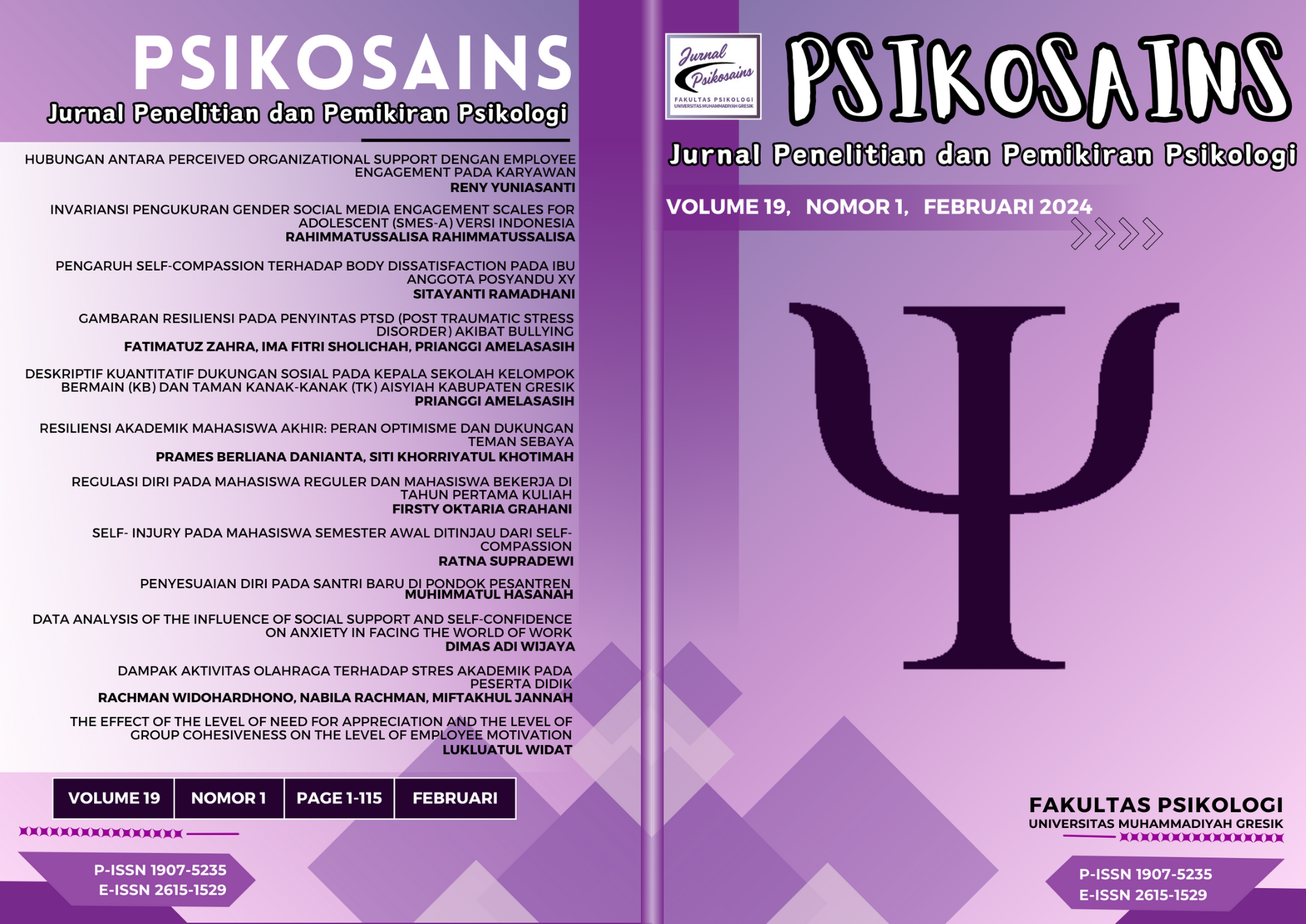INVARIANSI PENGUKURAN GENDER SOCIAL MEDIA ENGAGEMENT SCALES FOR ADOLESCENT (SMES-A) VERSI INDONESIA
DOI:
https://doi.org/10.30587/psikosains.v19i1.6720Keywords:
Social Media Engagement Scales for Adolescent, SMES-A, measurement invarianceAbstract
Background: Social Media Engagement Scales for Adolescent (SMES-A) is a
measurement tool that measures adolescents' engagement in using social media
consisting of 11 items with three dimensions, namely cognitive engagement,
affective engagement, and behavioral engagement. Objective: This study aims
to conduct a confirmatory factor analysis and test the gender measurement
invariance of the Indonesian version of the SMES-A in order to produce a scale
that has good psychometric characteristics. Method: This study was conducted
on the criteria of subjects aged 11-21 years totaling 851 using Confirmatory
Factor Analyses (CFA) statistical procedures first and then continued with
measurement invariance. Result: Based on the results of Confirmatory Factor
Analyses (CFA) shows that the factor structure of the Indonesian version of the
SMES-A with three factors fits the data and there is gender measurement
invariance. Conclusion: The Indonesian version of the SMES-A measurement
tool does not have measurement bias based on gender group differences.
References
Educational and Psychological Measurement, 45(1), 131–142.
https://doi.org/10.1177/0013164485451012
Alt, Dorit. (2015). College students’ academic motivation, media engagement
and fear of missing out. Computers in Human Behavior 49, 111-119.
http://dx.doi.org/10.1016/j.chb.2015.02.057
Social Media Engagement Scales for Adolescent (SMES-A) Versi Indonesia: Invariansi Pengukuran Gender
Rahimmatussalisa, Anwar, Mufit Nur Azizah Kusuma Putri
APJII. (2020).BuletinAPJII. Edisi 74. Diakses melalui:
https://apjii.or.id/downfile/file/BULETINAPJIIEDISI74November2020.pdf
Azwar, S. (2012). Penyusunan Skala Psikologi (2nd ed.). Yogyakarta: Pustaka Pelajar.
Azwar, S. (2012). Reliabilitas dan Validitas (4th ed.). Yogyakarta: Pustaka Pelajar.
Chen, F.F. (2007). Sensitivity of goodness of fit indexes to lack of measurement invariance.
Structural Equation Modeling: A Multidisciplinary Journal, 14(3), 464–504.
https://doi.org/10.1080/10705510701301834
Dessart, L. (2017). Social media engagement: a model of antecedents
and relational outcomes. Journal of Marketing Management, 33, 375-399,
https://doi.org/10.1080/0267257X.2017.1302975
Hair, J. F., Black, W. C., Babin, B. J., & Anderson, R. E. (2014). Multivariate Data Analysis (7th
ed.). London: Pearson Education Limited.
Hollebeek, L. (2011). Exploring customer brand engagement: definition and themes. J. Strateg. Mark.
19, 555–573. https://doi.org/10.1080/0965254X.2011.599493
Hu, L., & Bentler, P.M. (1999). Cutoff criteria for fit indexes in covariance structure analysis:
Conventional criteria versus new alternatives. Structural Equation Modeling: A
Multidisciplinary Journal, 6(1), 1-55.
Jayani, D. H. (2020). 10 Media Sosial yang Paling Sering Digunakan di Indonesia. Diakses melalui
https://databoks.katadata.co.id/datapublish/2020/02/26/10-media-sosial-yang-paling-sering-
digunakan-di-indonesia.
Kaplan, A. M., & Haenlein, M. (2010). Users of the world, unite! The challenges and opportunities
of social media. Business Horizons, 53(1), 59–68. https://doi.org/10.1016/j.bushor.2009.09.003
Khan, M. L. (2017). Social media engagement: what motivates user participation and consumption
on Youtube? Comput. Hum. Behav. 66, 236–247. https://doi.org/10.1016/j.chb.2016.09.024
Kline, R. B. (2010). Principles and Practice of Structural Equation Modeling (3rd ed.). New York,
NY: Guilford Press
Kusnandar, V. B. (2021). Pengguna Internet Indonesia Peringkat ke-3 Terbanyak di Asia. Diakses melalui: https://databoks.katadata.co.id/datapublish/2021/10/14/pengguna-internet-indonesia-
peringkat-ke-3-terbanyak-di-asia.
Manning, J. (2014.) Social media, definition and classes of. In K. Harvey (Ed.),
Encyclopedia of social media and politics, 1158-1162.
McCay-Peet, L., & Quan-Haase, A. (2016). A model of social media engagement: user profles,
gratifcations, and experiences. Information & Media Studies. https://doi.org/10.1007/978-3-
319-27446-1_9
Ni, X., Shao, X., Geng, Y., Qu, R., Niu, G., & Wang, Y. (2020). Development of the Social Media
Engagement Scale for Adolescents. Front. Psychol. 11.
https://doi.org/10.3389/fpsyg.2020.00701
Nguyen, T.H., Lin, K.H., Rahman, F.F., Ou, J.P., Wong, W.K. (2020). Study of depression, anxiety,
and social media addiction among undergraduate students. Journal of Management Information
and Decision Sciences, 23(4), 284-303.
Nunnally, J. C., & Bernstein, I. H. (1994). Psychometric Theory (3rd ed.). NY: McGraw-Hill, Inc
Paruthi, M., & Kaur, H. (2017). Scale Development and Validation for Measuring
Online Engagement. Journal of Internet Commerce, 16, 127-147.
https://doi.org/10.1080/15332861.2017.1299497
Pituch, K.A., & Stevens, J.P. (2016). Applied Multivariate Statistics For The Social Sciences Analyses
with SAS and IBM‘s SPSS Sixth Edition. New York: Routledge.
Schumacker, R. E., & Lomax, R. G. (2010). A Beginner’s Guide to Structural Equation Modeling
(3rd ed). New York: Routledge
Stevens, J. P. (1992). Applied Multivariate Statistics for the Social Sciences (2nd edition). Hillsdale,
NJ: Erlbaum.
Xanidis, N., Brignell, C.M. (2016). The association between the use of social network sites, sleep
quality and cognitive function during the day. Computers in Human Behavior, 55, 121-126.
https://doi.org/10.1016/j.chb.2015.09.004



